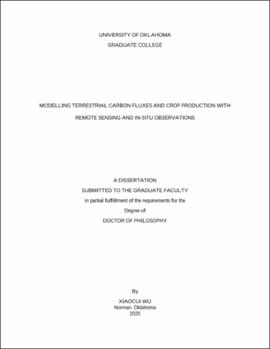| dc.description.abstract | Plants fix carbon through photosynthesis, sequestering carbon dioxide from the atmosphere and substantially mitigating the climate warming effect induced by anthropogenic CO2 emissions. Terrestrial gross primary production (GPP) through photosynthesis is crucial for understanding the land-atmospheric carbon exchange, which is the largest component and one of the most uncertain aspects of the global carbon cycle. Thus, accurate estimation of GPP can help better understand the global carbon budget, and the ecosystem sensitivity to the global climate change. Data driven models that utilize the climate data and remote sensing-based observations can provide reasonable estimates of GPP. The emergence of the solar induced chlorophyll fluorescence (SIF) from both in-situ and satellite observations provides another tool to understand and estimate plant photosynthesis. Remote sensing-based observations and models are also widely used in crop monitoring. Timely and accurate crop production estimation are needed to sustain global food security under the background of climate change. My overall objective is to improve the data-driven models to provide better GPP estimates, to combine SIF with other data sources to advance our understanding of the photosynthesis process and ecosystem sensitivity to droughts, and to investigate the potential of a data-driven model, specifically, the vegetation photosynthesis model (VPM), in crop monitoring.
In Chapter 2, we investigated the seasonal dynamics of eddy flux-derived GPP (GPPEC), solar-induced chlorophyll fluorescence (SIF), and four vegetation indices (VIs) and their relationships in a tall grassland site. We also examined drought impact on those structural and physiological proxies of plant photosynthesis. We found SIF explained 49% of the GPP variability at the seasonal scale, and had a stronger consistency with GPP than the four VIs. Among the four VIs, the soil background corrected VIs, near-infrared reflectance of vegetation (NIRv) and enhanced vegetation index (EVI) showed the best consistency with both GPP and SIF. In addition, SIF is more sensitive to drought than the VIs. This study suggested that the potential of SIF in tracking photosynthesis in grassland and drought impact on photosynthesis.
In Chapter 3, we improved the vegetation photosynthesis model (VPM) by considering the difference of the maximum light use efficiency for C3 and C4 croplands. Model validation against GPPEC in multiple sites distributed over CONUS suggests better accuracy of GPP simulated by VPM (GPPVPM) in tracking the cross-site variability and interannual variability (R2 = 0.84 and 0.46, respectively) when compared to MOD17 GPP. We also assessed the spatial and temporal (seasonal) consistency of GPPVPM, MOD17 GPP and other two common-used GPP products with the Global Ozone Monitoring Experiment-2 (GOME-2) SIF. We found good consistency of GPPVPM with SIF across space and time. Anomaly analyses for those GPP products and GOME-2 SIF showed that high GPP during the 2012 spring compensated for low GPP during the summer, resulting in near-neutral changes in annual GPP for the CONUS. This study demonstrates the need to improve light use efficiency models by incorporating C3 and C4 plant functional types, and the importance of assessing the impacts of different types and timing of climate extremes on GPP.
In Chapter 4, we evaluated the interannual dynamics of maize and soybean cropping areas and production over the CONUS during 2008-2018. We found an increase of maize and soybean planted areas during this period, mainly driven by markets and international trade. We further investigated the relationship between production and the total GPP derived from VPM simulation and the area statistics from cropland data layer (CDL). We found strong relationship between them. Additionally, the ratio between grain production and GPPVPM, named harvest index derived from GPP (HIGPP), ranged from 0.25 (2012) to 0.36 for maize and from 0.13 to 0.15 for soybean. The seasonal linear regression models between grain production and cumulative GPPVPM (GPPVPM_acc) over time at 8-day resolution shows that GPPVPM_acc accounted for ~90% variance of grain production by the end of July. Our findings suggest that the potential of VPM and GPPVPM data product in monitoring grain production to help farmers, decision makers, stakeholders and the public.
In Chapter 5, we assessed the consistency of winter wheat cropped areas from NASS statistics and planted area derived from CDL data. We found strong spatial-temporal consistency between the CDL and NASS datasets for the planted acreage. However, there is a significant difference (>40%) between the NASS harvested area and planted area from NASS statistics or CDL data in the Southern Great Plains, where winter wheat is used as both a grain crop and forage crop. We then evaluated the relationship between annual GPPVPM and grain production, we found a moderate linear relationship between them for winter wheat, with R2 value of 0.68 at county scale over the CONUS. But this relationship improved when excluding those counties with large difference between the CDL planted area and NASS harvested area. Our findings suggest that the importance of providing reliable in-season crop type classification in considering the difference between planted and harvested acreage, and the potential of GPPVPM in crop monitoring. | en_US |
